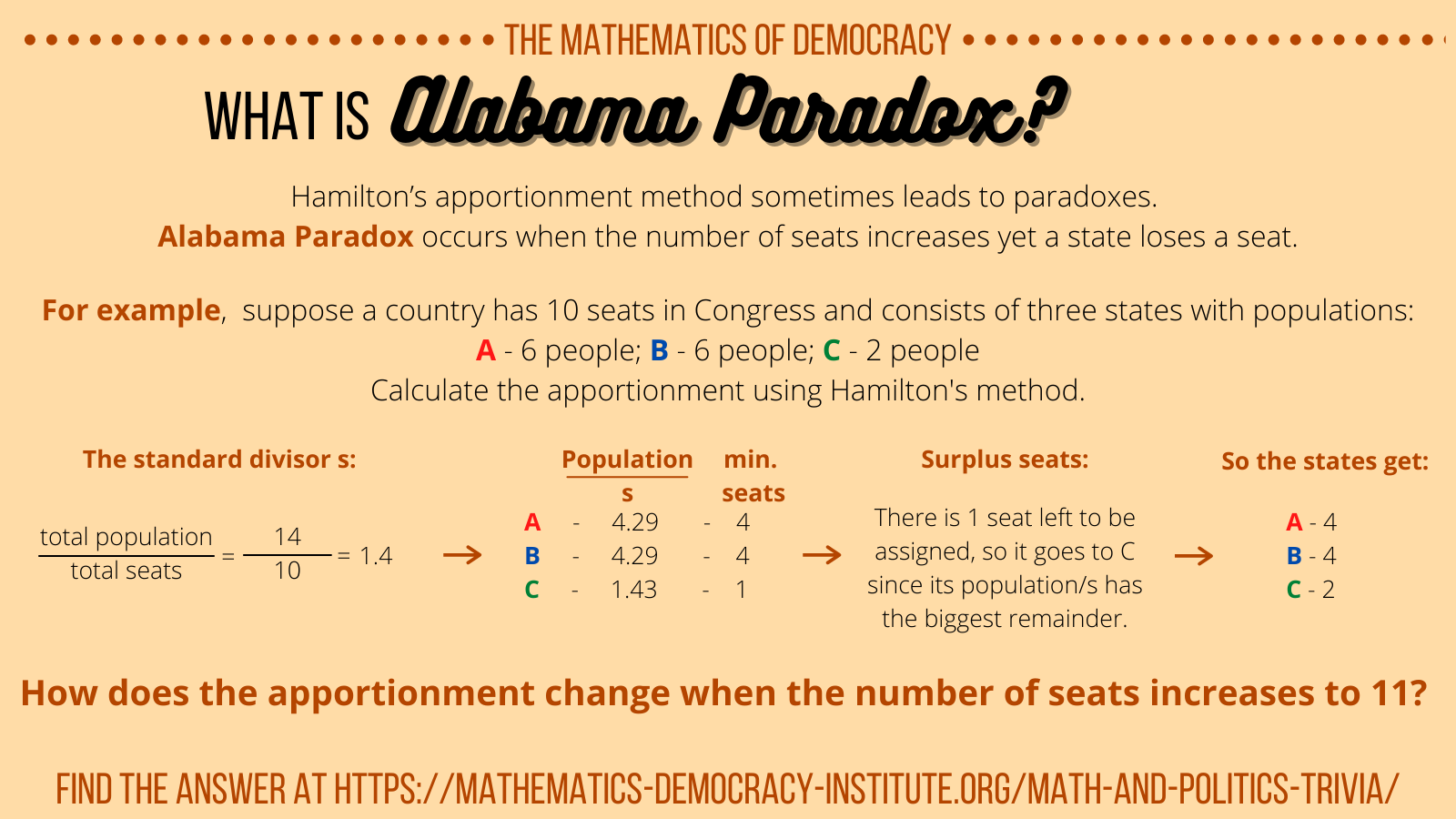The Alabama Paradox: Understanding the Quirks of Political Representation
Introduction:
Have you ever heard of the Alabama Paradox? It’s a fascinating phenomenon that challenges our understanding of political representation and the allocation of resources. In simple terms, the Alabama Paradox occurs when increasing an entity’s overall share of resources leads to a decrease in one or more of its sub-entities’ shares. This paradoxical outcome seems counterintuitive at first, but upon closer examination, it reveals the complex dynamics at play in politics and decision-making processes.
**What is the Alabama Paradox?**
The Alabama Paradox is a concept that originated in the field of economics and political science. It refers to a scenario where increasing the total number of seats allocated to a group or entity actually reduces the number of seats it holds in the legislature or other representative body. This paradox highlights the flaws in certain methods of allocation that are used to ensure proportional representation.
Let’s take a closer look at the Alabama Paradox and understand its implications.
**Understanding Proportional Representation:**
Proportional representation is a political principle aimed at ensuring that each group or entity’s representation mirrors its share of the population or voters. The goal is to create fair and equitable systems where everyone’s voice is heard.
To achieve this, various methods of seat allocation are employed, such as the Huntington-Hill method. This method, also known as the method of equal proportions, uses a formula to calculate the optimal distribution of seats.
**The Dynamics of the Alabama Paradox:**
The Alabama Paradox arises due to the nature of seat allocation methods, such as the Huntington-Hill method. This method takes into account both the overall population and the population of each sub-entity when determining the allocation of seats.
Let’s say we have a legislature with a certain number of seats to distribute among several sub-entities. Initially, if the total number of seats allocated to the legislature is increased, it might seem that each sub-entity would gain more seats. However, that is not always the case.
In systems with sub-entities that have varying population sizes, an increase in the overall number of seats can disproportionately benefit larger sub-entities, leading to a decrease in the number of seats for smaller sub-entities. This creates a paradoxical situation where boosting the total number of seats results in an unfair outcome for some sub-entities.
**Real-World Examples of the Alabama Paradox:**
The Alabama Paradox has been observed in various real-world scenarios, highlighting the complexities of political representation.
1. Legislative Redistricting: When redrawing legislative districts, attempts to ensure proportional representation can unintentionally result in the Alabama Paradox. By redrawing boundaries to create more equally sized districts, the representation of certain minority groups or smaller communities may be diminished.
2. College Admissions: In some college admissions processes, a similar paradox can occur. When striving for diversity and representation, institutions might increase the overall number of seats allocated to certain groups, inadvertently reducing the chances of admission for some individuals within those same groups.
3. Party Politics: The Alabama Paradox can also be observed within political parties. Allocating more seats to increase diversity or representation within the party can inadvertently lead to the marginalization of certain factions or groups within the party.
**Factors Contributing to the Alabama Paradox:**
Several factors contribute to the occurrence of the Alabama Paradox:
1. Population Disparities: When sub-entities have significantly different population sizes, increasing the overall number of seats can disproportionately benefit larger sub-entities.
2. Seat Allocation Methods: The specific method used to allocate seats also plays a role in the occurrence of the Alabama Paradox. Different methods may mitigate or exacerbate the paradox to varying degrees.
3. Competition for Resources: The Alabama Paradox often arises when there is competition for limited resources, such as seats in a legislature or spots in a college admissions process.
**Mitigating the Alabama Paradox:**
While the Alabama Paradox can pose challenges to fair representation, there are ways to mitigate its effects and ensure a more equitable allocation of resources. Here are a few strategies:
1. Adjust Seat Allocation Methods: The choice of seat allocation method can significantly impact the occurrence of the Alabama Paradox. By using alternative methods that consider different factors or employ modifications, it is possible to reduce the paradox’s occurrence.
2. Redistricting with Caution: Redrawing district boundaries should be done with caution to ensure proportional representation without unintentionally marginalizing specific communities. Careful consideration should be given to population disparities and the impact on representation.
3. Analyze and Modify Policies: In cases where the Alabama Paradox is observed within specific policies or systems, analyzing their effects and modifying them accordingly can help to address the unfair outcomes.
**Frequently Asked Questions**
**Q: Is the Alabama Paradox limited to the state of Alabama?**
No, the term “Alabama Paradox” is not specific to the state of Alabama. It was named after the University of Alabama, where it was first identified. The paradox can occur in various contexts, both within and outside Alabama.
**Q: Are there other paradoxes related to political representation?**
Yes, there are other paradoxes related to political representation, such as the Population Paradox and the New States Paradox. These paradoxes also highlight the complexities of fair representation and the challenges in creating proportional systems.
**Q: Can computer algorithms help solve the Alabama Paradox?**
Computer algorithms can help in mitigating the effects of the Alabama Paradox by simulating different scenarios and test the fairness of seat allocation methods. They can assist in identifying the most optimal methods that minimize unfair outcomes and promote proportional representation.
**Final Thoughts**
The Alabama Paradox sheds light on the intricate dynamics of political representation and the challenges faced in allocating resources fairly. It serves as a reminder that simple solutions may not always yield equitable outcomes and that thoughtful consideration of various factors is crucial. By analyzing the Alabama Paradox and implementing strategies to mitigate its effects, we can strive towards more robust and representative systems that accurately reflect the diverse populations they serve.
